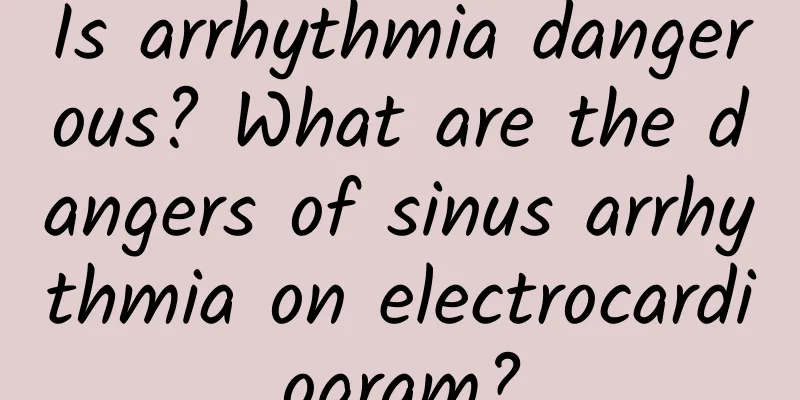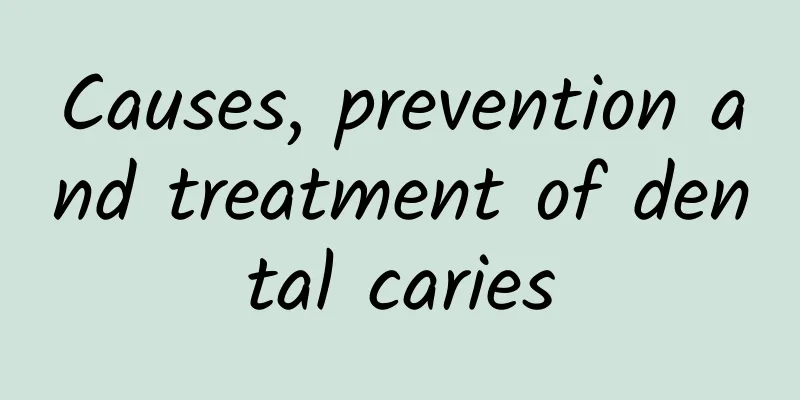Is arrhythmia dangerous? What are the dangers of sinus arrhythmia on electrocardiogram?

|
There is an item called heart rate check in the physical examination. Some people's physical examination reports will be told that they have irregular heartbeats. At first glance, it may make people think that their heart function is not good, which will make people very worried. However, common irregular heartbeats are actually normal. Let's learn more about it. Is arrhythmia dangerous?If a diagnosis of arrhythmia appears in the physical examination report, the most common one is sinus arrhythmia, which is the most common type of arrhythmia and often occurs in healthy people, especially teenagers. Its mechanism is related to respiratory factors and is physiological, so it generally does not require treatment. However, there is another common arrhythmia in clinical practice, which is atrial fibrillation. According to relevant statistics, the incidence of atrial fibrillation in adults is about 3%. The prevalence of atrial fibrillation is higher in elderly patients and patients with other diseases such as hypertension, heart failure, coronary heart disease, obesity and diabetes. And with the increase of age, the prevalence of atrial fibrillation increases further. According to statistics, the incidence of atrial fibrillation in the elderly over 80 years old is nearly 10%. Generally speaking, there are fewer patients with simple atrial fibrillation, and they usually have some organic heart diseases, such as hypertension, coronary heart disease, etc. If atrial fibrillation occurs, it will show an absolute irregular heart rate on the electrocardiogram, but unlike sinus arrhythmia, atrial fibrillation is a pathological phenomenon and should be actively treated symptomatically. In terms of treatment, we should start with preventing thrombosis and controlling ventricular rate. Different drug treatments should be adopted according to different conditions of patients. For example, patients with atrial fibrillation combined with heart failure often choose digitalis drugs or beta-blockers to control ventricular rate. What are the dangers of sinus arrhythmia on electrocardiogram?In most cases, the patient's sinus arrhythmia is actually "respiratory sinus arrhythmia", which is a normal physiological phenomenon. It means that the heart rate changes with breathing, the inhalation increases, the exhalation slows down, and this cycle is equivalent to a breathing cycle. When the breath is restored, the heart rhythm is normal. It is more common in young people. Generally speaking, the heartbeat will be faster or slower between breaths. This is due to the relationship between nerve regulation. The change in the tension of the vagus nerve affects the pacemaker frequency of the sinoatrial node. When a person inhales, the tension of the vagus nerve decreases, and the heartbeat will speed up; when it comes to exhaling, the effect of the vagus nerve is stronger, and the heartbeat will slow down. If the difference in speed is large, the heart rhythm will be irregular. This type of sinus arrhythmia that changes with breathing is generally physiological and does not require special treatment. If it is unrelated to breathing or caused by other arrhythmias, there will be other clinical and electrocardiographic manifestations. Patients do not need to worry. If there are no other uncomfortable symptoms, they can live a normal life without treatment. Patients diagnosed with sinus arrhythmia can pay attention to the correlation between their daily heart rate changes and breathing. Do arrhythmias need treatment?Clinically, there are many patients with arrhythmia, but not all of them need treatment. Patients must be clear about their own disease type. Harmless arrhythmia may not need treatment, and random medication may cause more serious arrhythmia. Whether treatment is needed can be determined based on the following principles: 1. Heart rate. The heart rate here refers to the average heart rate including the instant heart rate. Studies have shown that abnormal heart rate is not conducive to cardiovascular protection. It is important to note that the critical point of heart rate is <85 and >50bpm. 2. Duration: The longer the arrhythmia lasts, the greater the harm to the body. 3. Atrioventricular dissociation. Arrhythmias associated with atrioventricular dissociation are more harmful. 4. Whether there is heart disease or not. The hazards of arrhythmia and organic heart disease are superimposed. |
Recommend
I always feel like there is gas in my stomach. What's going on?
After dinner Some people experience "flatule...
Do not eat wild mushrooms
The hot and humid environment in July is particul...
Should I take medicine three times a day with my meals? Many people take it wrong...
When we take medicine, we often see "three t...
Taste becomes stronger after pregnancy
After pregnancy, many women will undergo a series...
What should I do if a pregnant woman vomits after drinking water?
Morning sickness is a symptom that many expectant...
Why is autumn the best season for moxibustion? What are the precautions for moxibustion in autumn?
Moxibustion is an important treatment in traditio...
Why do girls have a bad smell down there?
Many female friends have noticed that they have a...
Adrenal hyperplasia in women
The adrenal cortex is the external tissue located...
Taboos of drinking ginger soup and brown sugar water during menstruation
Ginger and brown sugar are generally consumed mor...
What are the symptoms of pregnancy during the luteal phase?
The follicular phase is a period of safe menstrua...
How to supplement thalassemia in pregnant women
After becoming pregnant, women must pay special a...
New research shows that skipping dinner is good for you. Who is not suitable for this diet?
Recently, it has been widely circulated in the ci...
Is it normal to have one side of the vagina enlarged?
Although the female genitals are in a very privat...
Is it the menstrual period if there is a lot of vaginal discharge?
Excessive vaginal discharge may be due to menstru...









